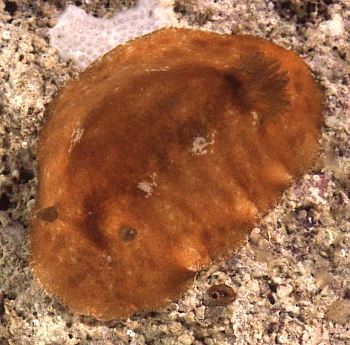
Platydoris sp. 5
Order: NUDIBRANCHIA
Suborder: DORIDINA
Superfamily: EUDORIDOIDEA
Family: Dorididae
PHOTO
Heron Island [Great Barrier Reef], under a dead coral slab on reef crest, October 2000. 45mm long. Photo: Julie Marshall
Authorship detailsRudman, W.B., 2003 (March 18) Platydoris sp. 5 [In] Sea Slug Forum. Australian Museum, Sydney. Available from http://www.seaslugforum.net/find/platsp5
Related messages
?Platydoris from Solomon Ids
July 27, 2004
From: Bruce Potter
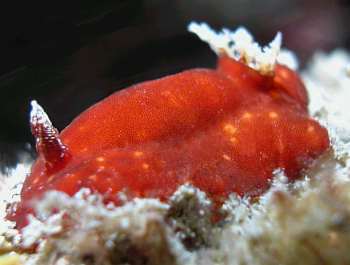
Dear Bill,
I found the attached nudibranch on a night dive in April of this year, at a site called Leilei, just on the outskirts of Honiara, Solomon Islands.
This is a coral and rubble site. It was at about 8 meters depth, and was about 20mm long. I have not been able to find it in any of my books. Can you help please?
Regards
Bruce Potter
bac@solomon.com.sb
Potter, B., 2004 (Jul 27) ?Platydoris from Solomon Ids. [Message in] Sea Slug Forum. Australian Museum, Sydney. Available from http://www.seaslugforum.net/find/12695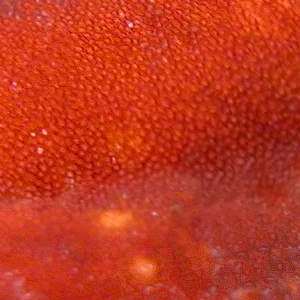
Dear Bruce,
There are still quite a few brownish-reddish dorids which still need working on, bit in tropical waters and temperate parts of the world. Although in profile and colour, your animal looks like a species of Rostanga I suspect the lack of the characteristic bristly caryophyllidia on the mantle rules that identification out. From your photo it seems to have low tubercles which could suggest it is a species of Platydoris, possibly a juvenile of the animal I am calling Platydoris sp. 5.
Best wishes
Bill Rudman
Platydoris sp. from Heron Island
March 23, 2003
From: Julie Marshall

Dear Bill,
Attached are some pictures of a 45mm Platydoris sp. found at Heron Island [Great Barrier Reef] under a dead coral slab at the reef crest at low tide in October 2000. The colour of its mantle is brown with irregular white patches on either side of the centre of the mantle. The undersurface of the mantle and foot is creamish-white with a band of brown dots around, and on, the foot. The rhinophores are brownish-grey with white tips. The gills are brown with grey edges.
I have been calling this species Platydoris cf. tabulata but Dorgan, Valdes and Gosliner (2002) in their recent paper regarded the name Platydoris tabulata as a nomen dubium and assigned other records of P. tabulata to either P. sanguinea or to a new species, P. cinereobranchiata. The Heron Island animal does not seem to fit in with either of these species. P.sanguinea has white spots on the rhinophores and the branchial leaves are white. The gills of my animal are brownish-grey and lacked white colouration and it certainly looks nothing like Bergh’s (1905) illustration. P. cinerobranchiata has a tan body colour with small black spots and large orange-red blotches. Its description makes no mention of white patches on the mantle and my specimen definitely had no large orange-red blotches.
References:
• Bergh, L.S.R. (1905) Die Opisthobranchiata der Siboga-Expedition. Leiden, E. J. Brill. 248 pp.
• Dorgan, K.M., Vales, A. and Gosliner, T.M. (2002) Phylogenetic systematics of the genus Platydoris (Mollusca, Nudibranchia, Doridoidea) with descriptions of six new species. Zoologica Scripta, 31(3): 271-319.
Best wishes,
Julie Marshall
juliemarshall@netspace.net.au
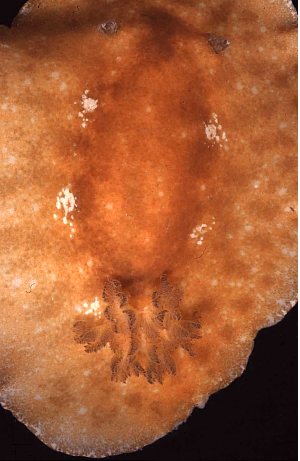
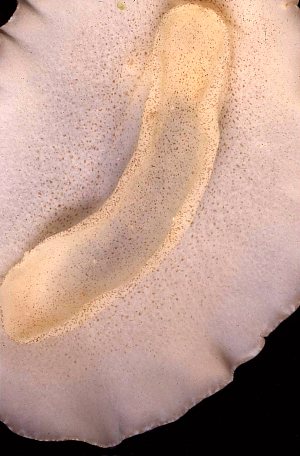
Dear Julie,
Sorry its taken me a while to post your message. I had hoped to find a moment to add my comments to yours if not actually answer your problem but I need a 48hr day. I think there are still some unresolved problems in the Platydoris group, but at least we have now have a starting point. At this stage I'll list your animal as Platydoris sp. 5.
Best wishes,
Bill Rudman
